Lunes en papier
Year: 1921
Author: André Malraux (1901 - 1976)
Artist: Fernand Léger (1881 - 1955)
Publisher: Éditions de la Galerie Simon
Through Max Jacob's connections, Malraux had grown familiar with the world of the visual arts. He grew acquainted with Daniel-Henry Kahnweiler (1884-1979), who was born in Mannheim and opened a small gallery in Paris. Kahnweiler immediately recognised the importance of the work of Picasso, Braque, Gris and Léger, Cubist artists -'des jeunes farceurs' (young pranksters), as the press tended to call them. Their work was generally considered terribly ugly and unbearably pretentious. But thanks to Kahnweiler, they were still able to sell their work. He defended them from the gutter press, and so Cubism was able to establish a foothold in the art world.
Kahnweiler as a publisher
Besides being an art dealer, Kahnweiler was also a publisher. Between 1909 and 1914 he published a small number of books by Guillaume Apollinaire and Max Jacob, illustrated by André Derain and Picasso. In his opinion, these authors - who were still unknown at the time - accomplished with words what the Cubist painters did with paint. Kahnweiler's activities were interrupted by World War I, a period he was forced to spend in Switzerland. His possessions were seized because he was a German citizen. But he still succeeded in starting over after the war under the name of his good friend André Simon. Between 1920 and 1940, the Éditions de la Galerie Simon, on Rue d'Astorg 29bis, was to publish a large number of fine editions by authors such as Max Jacob, Raymond Radiguet, Pierre Reverdy, Antonin Artaud, and many others. These were of course illustrated by the famous artists in Kahnweiler's gallery.
Lunes en papier bears seven (large and small) abstract presentations with a varied pattern of circular motifs, lines and blocks in black-and-white. It is the first book to be illustrated with wood engravings by Fernand Léger. The cover bears the Kahnweiler seal: two shells surrounding his monogram. Léger caused a sensation at the Salon des Indépendants in 1911 with his 'Nude in the woods' (Nus dans la forêt). Kahnweiler was immediately intrigued and attempted to contact its creator, who had previously made a living as a draughtsman for an architectural firm. Léger was mockingly called 'tubiste' because of his tube-like presentations: he felt isolated and unappreciated. The contract with Kahnweiler changed his life completely. Léger would always remain grateful to him.
Absurdism
Lunes en papier was published in a small edition: only 112 copies were printed, of which this copy was printed on Dutch Van Gelder paper, and provided with the autographs of the author (in black pen) and artist (in purple pencil). Lunes en papier continually subverts the reader's expectations, starting with the cryptic subtitle and the warning in the front of the book: 'there is nothing symbolical in this book'. The three stories are absurdist in nature, with strange plot turns and metaphors, airy, sometimes humorous in tone, while still dealing with seemingly serious matters, and ending with the death of Death.
The book was dedicated to Max Jacob, the bizarre writer who had become acquainted with Malraux in 1919, and whose influence is noticeable in Lunes en papier. Malraux would later qualify his first effort as a 'gloire de café'. But it suited the Surrealist and Dadaist ideas of its time extremely well. Kahnweiler remained proud of the fact that he had published the first book by André Malraux, whose career culminated in the position of Minister of Culture under Charles de Gaulle. Malraux responded to Kahnweiler's show of respect by decorating him with the Légion d'honneur as a birthday gift. Kahnweiler however declined this honour: he had no sympathy for 'the State', and even less for the State's interference with the arts.
Bibliographical description
Description: Lunes en papier : petit livre où l'on trouve la relation de quelques luttes peu connues des hommes, ainsi que celle d'un voyage parmi des objets familiers mais étranges / André Malraux ; le tout selon la vérité et orné de grav. sur bois également très véridiques par Fernand Léger. - Paris : Simon, 1921. - [34] p. : ill. ; 32 cm
Printer: Birault (Paris)
Edition: 112 copies
This copy: Number 22 of 102 on Dutch Van Gelder
Note: Signed by the author and the artist
Bibliography: Carteret IV-262 ; Hogben 64 ; Johnson 34 ; Mahé compl.-50 ; Monod 7696
Shelfmark: KW Koopm A 173
References
- Pierre Assouline, L'homme de l'art: D.-H. Kahnweiler (1884-1979). Paris, Balland, 1988
- Paul van Capelleveen, Sophie Ham, Jordy Joubij, Voices and visions. The Koopman Collection and the Art of the French Book. The Hague, Koninklijke Bibliotheek, National Library of the Netherlands; Zwolle, Waanders, 2009
- Paul van Capelleveen, Sophie Ham, Jordy Joubij, Voixet visions. La Collection Koopman et l'Art du Livre français. La Haye, Koninklijke Bibliotheek, Bibliothèque nationale des Pays-Bas; Zwolle, Waanders, 2009
- Daniel-Henry Kahnweiler. Paris, Centre Georges Pompidou, 1984
- Fernand Léger. Paris, Centre Georges Pompidou, 1997
- Fernand Léger 1911-1924: The rhythm of modern life. Munich, Prestel, 1994
- André Malraux, Oeuvres complètes,I. Paris, Gallimard, 1989
- Christiane Moatti, 'Lunes en papier signé Léger et Malraux', in: Europe: Revue littéraire mensuelle, 75 (1997), 818/819, p. 122-135
- Olivier Todd, André Malraux: Une vie. Paris, Gallimard, 2001
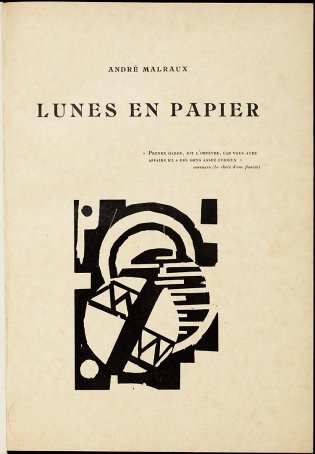
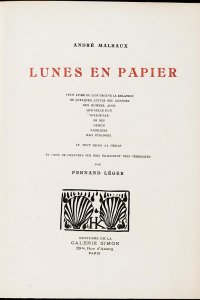
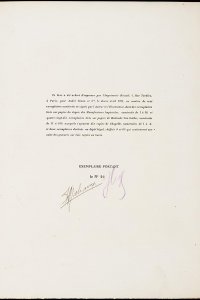
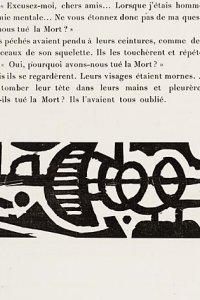
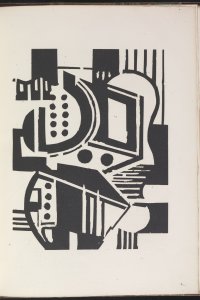
![Houtsnede door Fernand Léger (p. [11])](/sites/default/files/styles/galerie/public/images/lunes-en-papier-p11.jpg?h=4e5a1cfe&itok=3SacCo8i)
![Houtsnede door Fernand Léger (p. [21])](/sites/default/files/styles/galerie/public/images/lunes-en-papier-p21.jpg?h=dee8ca9a&itok=-Gu-nKsj)